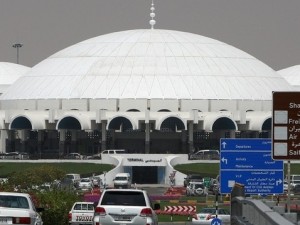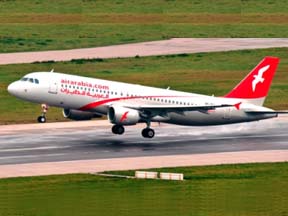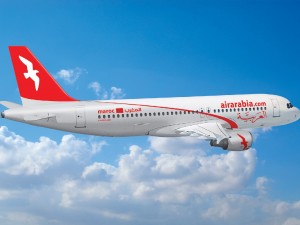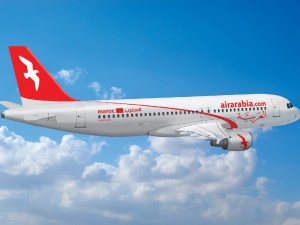Sharjah International Airport registered a 10 percent year-on-year increase in passengers, handling 11 million passengers from January to December 2016. The airport passed the 10 million passenger mark for the first time in 2015, showing 5.5 percent growth. Since then, the airport has continued to show strong growth. Airport passengers increased 12 percent during the first quarter of 2016, 11 percent during Q2 and 13 percent during Q3, reaching one million passengers per month for the first time in August 2016. Aircraft movements at Sharjah International Airport increased by 6 percent to 75,900 scheduled and non-scheduled movements in 2016 compared with 71,426 in 2015. Sharjah International Airport’s growth has been driven by its strategic location, the success of Sharjah’s in-bound tourism industry and the expansion of Sharjah-headquartered Air Arabia. The airport’s ideal location, close to Sharjah city, Dubai city and the main highways connecting the country’s seven emirates, has made it a convenient hub for both business and leisure travelers.Whilst Air Arabia hasn’t yet announced overall figures for 2016, the airline served over 2.27 million passengers during the first nine months of 2016, a 14 percent increase compared to the 2 million passengers during the same period of 2015. The airline currently operates a fleet of 46 Airbus A320 aircraft offering flights to over 120 destinations in 33 countries from five hubs across the Middle East, Africa, Asia, and Europe.
Read More »Air Arabia 3Q revenue touches AED 1.12 billion
Air Arabia’s net profit for the third quarter of 2016 was AED297 million, up 26 per cent compared to AED 235 million reported in the corresponding period of 2015. For the three months ending September 30, 2016, the airline posted a turnover of AED1.12 billion, in line with the revenue generated in the same period of 2015. Air Arabia served over 2.27 million passengers in the third quarter of 2016, a 14 per cent increase compared to 2 million passengers in the same period of last year. The average seat load factor — or passengers carried as a percentage of available seats — for the same quarter stood at an impressive 81 per cent. Air Arabia’s net profit for the first nine months of 2016 stood at AED 542 million, up 15 per cent compared to AED 472 million reported in the corresponding period of 2015. For the nine months ending September 30, 2016, the airline posted a turnover of AED 2.96 billion, an increase of 3 per cent compared to AED 2.86 billion in the same period of 2015. The low-cost aviation pioneer served over 6.3 million passengers in the first nine month of 2016, a 14 per cent year-on-year increase. The average seat load factor — or passengers carried as a percentage of available seats — for the same period stood at an impressive 80 per cent.
Read More »13% increase in passengers at Sharjah airport this summer
Sharjah International Airport handled 2,996,433 passengers during July, August and September this year, a 13 percent increase over the same period in 2015. Overall, the number of inbound, outbound, transit and transfer passengers handled during the first nine months of the year increased by 12 percent, compared to the same period last year, to total 8,344,293. Sharjah airport recorded its first million-passenger month in August, with the months of July and September falling just slightly short of the million passenger mark. Meanwhile, 20,362 aircraft take-offs and landings were handled during the July to September period, 8 percent more than the equivalent period during 2015. Airlines have added a number of new connections from Sharjah International Airport this year, including new Air Arabia routes from Sharjah to Batumi (Georgia) and to Sarajevo (Bosnia and Herzegovina). Indian international airlines Air India Express and Jet Airways have both launched new Sharjah routes this year catering to business travellers and tourists, plus Indian expatriates working in the UAE. Jet Airways added new daily routes to Mangaluru (IXE) and Kozhikode (CCJ), while Air India Express has introduced new flights to Mumbai (SAHAR), Chandigarh (IXC) and Tiruchirapalli (TRZ) airports. Turkish airline, AtlasGlobal, also launched a new Sharjah route in April, adding a three-times-weekly service to Istanbul Atatürk International Airport. More new airline routes are planned for the next few months including the addition of a Hyderabad to Sharjah service from Jet Airways in December 2016 and a new Sharjah to Baku service from Air Arabia scheduled for 23 March 2017. Sharjah International Airport surpassed 10 million passengers per annum for the first time during 2015 and plans to handle 25 million passengers per annum by the …
Read More »New service to Baku by Air Arabia
Air Arabia has expanded its international route network with a new service to Baku, the capital of Azerbaijan. Starting 23 March 2017, the airline will operate four weekly flights from its primary Sharjah International Airport hub. On Thursdays and Sundays, the flight will depart Sharjah at 07:55 and arrive at the Heydar Aliyev International Airport in Baku at 10:50 local time, with the return flight scheduled from Baku at 11:30 destined to reach Sharjah at 14:10 local time. On Tuesdays and Saturdays, the flight will depart from Sharjah at 14:55 to land in Baku at 17:50 local time, and make its return journey starting 18:50 at Baku and land at Sharjah International Airport at 21:30 local time. The launch of the new flights follows a joint cooperation between Air Arabia, Azerbajian Airlines and local authorities aimed at promoting the new route connecting Baku and Sharjah. Sitting on the crossroads of Europe and Asia, Azerbaijan’s largest city also serves as the country’s financial nerve centre. Baku invites business and leisure travellers to its unique urban setting where ancient stone mansions co-exist with newly developed skyscrapers and mosques that stand as architectural marvels.
Read More »Air Arabia sees 14% rise in passengers in H1 2016
Sharjah-headquartered Air Arabia has reported a 14 percent increase in passenger numbers, carrying 4.1 million passengers during the first six months of 2016, compared with 3.6 million during the same period of 2015. The airline also announced a 3.5 percent increase in net profit, compared with a 4 percent drop in net profit in H1 2015. Despite regional economic uncertainties resulting from lower oil prices, the airlines turnover for the first six months of 2016 grew 5.5 percent, reaching AED 1.84 billion (US$ 0.5b), compared to AED 1.75 billion (US$ 0.48b) in the corresponding period last year. Air Arabia had a strong start to 2016, checking in more than 2.1 million passengers during the first quarter of the year, up 17 percent on the first quarter of 2015. In the second quarter of 2016, the airline flew over 2 million passengers, increasing 12 per cent on Q2 2015. The airline’s average seat load factor (passengers carried as a percentage of available seats) stood at 81 percent in the first quarter, 78 per cent in the second quarter and 79 percent overall during the first half of the year. The budget carrier’s home base, Sharjah International Airport, registered a 12 percent increase in overall passenger traffic over the first six months of 2016, with a total of 5.35 million passengers passed through the airport from January to June 2016, compared to 4.79 million in the same period last year. Passenger numbers handled by Sharjah airport exceeded 10 million for the first time during 2015. Air Arabia added five new international routes since the beginning of 2016, now operating flights to over 120 destinations in 33 countries across the Middle East, Africa, …
Read More »Air Arabia’s new services to Batumi, Georgia
Air Arabia has touched down in Batumi, the second largest city of Georgia. The airline operates two weekly flights to Black Sea port city from its primary Sharjah International Airport hub on Thursday and Saturdays at 13:15, arriving at Batumi at 16:40. The return flights are scheduled to leave Batumi International Airport at 17:30 to arrive in Sharjah at 20:50.
Read More »Air Arabia introduces next-gen management system
Air Arabia introduces SITA’s next-generation passenger management system to extract even greater efficiency across its operations. Air Arabia carried close to 8-million passengers in 2015, serving 101 destinations spread across the Middle East, North Africa, Asia and Europe from five hubs in the UAE, Egypt, Morocco and Jordan. SITA’s latest passenger service system will help the airline better manage the boarding of passengers across all destinations while streamlining the turnaround of the airline’s aircraft. Through the Horizon Passenger Management and Distribution portfolio, SITA will provide the airline with its latest departure control and weight and balance systems. Horizon Weight & Balance will increase fuel savings for the airline by providing full load planning capabilities, including a graphical user interface framework, for all the functionalities required to load and dispatch an aircraft. This includes all legally required documentation for both airlines and ground handlers. SITA’s Horizon Departure Control Services (DCS) is a fully integrated multi-host system for automated check-in, boarding and load planning and has been used to check in more than 167 million passengers worldwide.
Read More »Air Arabia records 34% rise in net profit
Air Arabia has announced that they have exceeded analyst expectations and their turnover has increased by 7 per cent to AED 946 million with an increase of 17 per cent in passenger numbers to 2.1 million as well. The airline reported a net profit of AED114 million for the three months ending March 31, 2016, a 34 percent higher than the corresponding 2015 figure of AED85 million. In the same period, Air Arabia posted a turnover of AED946 million, an increase of 7 percent on AED886 million in the first quarter of last year. The airline flew more than 2.1 million passengers between January and March 2016, up 17 percent on the corresponding period of last year. The airline’s average seat load factor – or passengers carried as a percentage of available seats – during the first three months of 2016 stood at an impressive 81 per cent.
Read More » Tourism Breaking News
Tourism Breaking News





